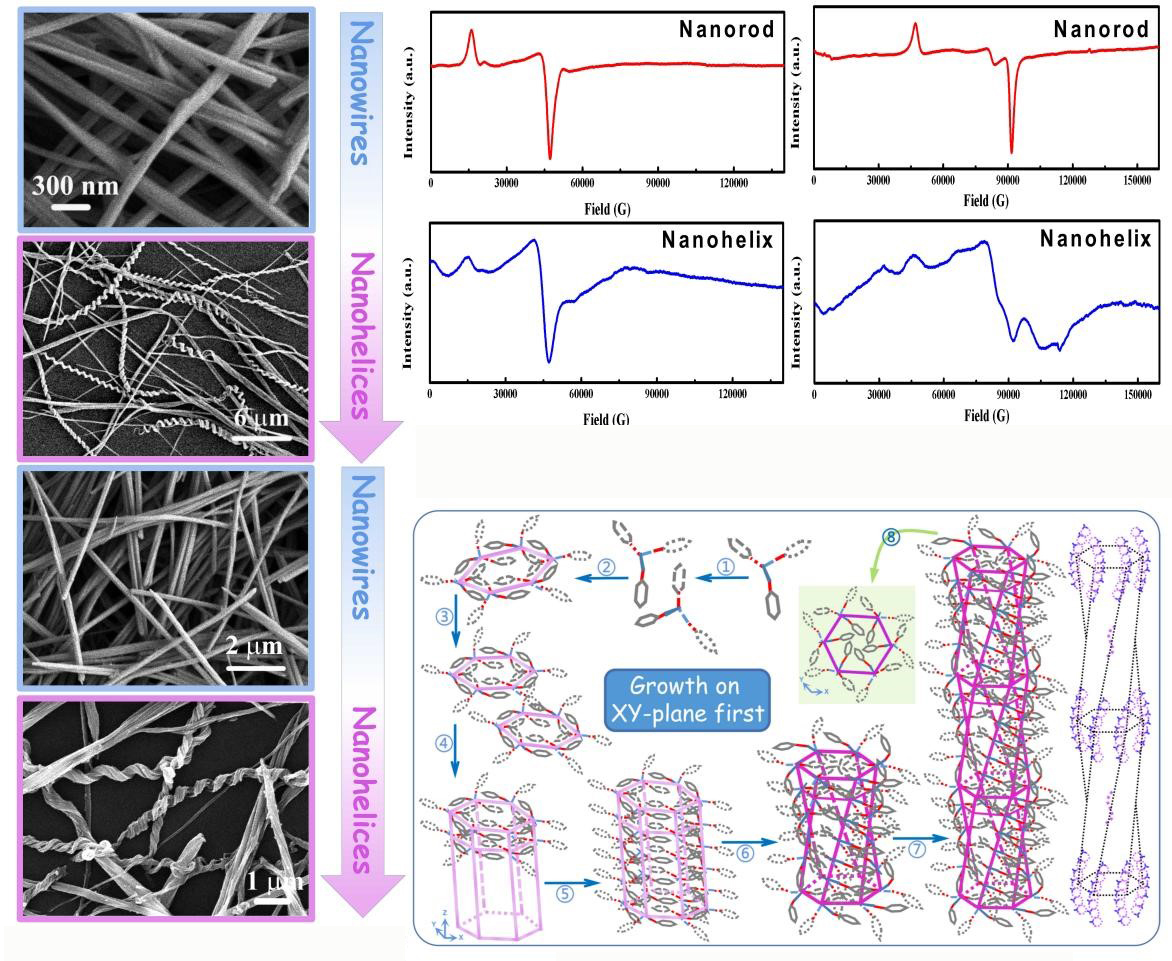| Sep 13, 2023 |
Scientists unlock reversible twisting of nanoscale materials
(Nanowerk News) For the first time, researchers have synthetically produced nanoscale helices that can be repeatedly twisted, untwisted, and retwisted between two stable forms. This breakthrough, published in Nature Communications ("Twisting, untwisting, and retwisting of elastic Co-based nanohelices"), demonstrates an unprecedented, reversible transformation of nanoscale crystalline materials.
|
|
The achievement could have wide-ranging impacts in materials science and crystallography. It introduces the concept of "elastic" crystals whose structures can change back and forth, as well as the possibility of designing manifold reversible transformations. The research provides a new perspective on crystallization processes and intermolecular interactions.
|
|
"We report the first synthesis of switchable cobalt-based nanohelices through a self-twisting mechanism without the need for any additive, template, substrate, or high-temperature process," said Dr. Qingyi Lu, leader of the research team at Nanjing University. "The as-synthesized nanohelices have an unusual 'elasticity,' reflected in the reversible changes of the lattice parameters and the mutual transformation between the nanowires and nanohelices."
|
 |
| Left. Scanning electron microscopy images of the nanowires and nanohelices; Upper right. electron paramagnetic resonance spectra of the nanorods and nanohelices; Lower right. Theoretical calculations and growth mechanisms of nanohelices. (Image by WANG Jihao)
|
|
In natural systems, twisting and untwisting often appear in tandem, such as in the coil and uncoil of DNA strands. However, inducing twisting in synthetic nanoscale materials has been extremely challenging. The reverse process of untwisting is even more rare and difficult to control.
|
|
The researchers accomplished this feat by delicately balancing the energies in the crystal structure of their cobalt-based nanomaterial. This balance allowed nanowires synthesized under different conditions to transition between straight and twisted in a repeatable manner.
|
|
The twisting force was found to originate from a competition between chemical condensation reactions and stacking interactions as the crystals formed. This mechanism differs from previous explanations of why some nanoscale materials twist spontaneously.
|
|
Using this knowledge, the team produced initially straight cobalt-salicylate nanowires, then converted them to twisted nanohelices by adjusting the temperature and reaction time. Remarkably, they managed to untwist these helices back into straight wires again by further changing the conditions.
|
|
After this untwisting, the straight wires could once again be re-twisted into helices by prolonging the low-temperature growth process. Thus, for the first time, reversible twisting was achieved through synthetic control of crystallization.
|
|
Compared to their straight counterparts, the helical nanostructures displayed advantages as a magnetic material and catalyst for oxygen reactions. But the ability to interchange twisted and straight forms also has intrinsic value for creating transformable nanoscale devices.
|
|
"The realization of the twisting-untwisting-retwisting cycle enriches the concept of crystal transformation and provides a new thought for designing reversible processes relying on special mutual effects between molecular interaction and crystal configuration," said Dr. Lu.
|
|
The team also confirmed that the twisting process could be generalized to form other metal nanohelices by substituting nickel and cobalt-nickel for cobalt in the synthesis. Furthermore, they converted the twisted precursor helices into inorganic cobalt and nickel oxide helices with retained helical shapes.
|
|
This suggests a strategy for integrating twisting capabilities into a wide range of functional nanomaterials for areas like energy storage, catalysis, and flexible electronics.
|
|
The achievement builds upon decades of research into inducing and controlling chirality in synthetic crystals. But while past studies achieved partial twisting or stable spiral shapes, none produced crystals with bidirectional twisting capabilities.
|
|
"The whole transformation process with reversible twisting capability is of importance, which provides a platform to study the novel behavior of subtly balanced systems," the researchers wrote.
|
|
Besides implications for nanotechnology and crystallography, the findings open questions about how finely competing interactions in a chemical system can be manipulated to reversibly alter physical forms. This phenomenon parallels bidirectional changes observed in some natural systems, such as the curling and uncurling of plant tendrils during cycles of day and night.
|
|
The nanomaterial twisting demonstrated here required meticulous synthesis and processing. But the study provides proof that under precisely defined conditions, reversible transitions between crystalline states can be obtained synthetically. This paradigm-shifting possibility warrants further investigation to fully understand the detailed energetics and leverage similar effects in other nanomaterials.
|
|
With further research, the unique "elastic" crystals may find applications ranging from encryption to nanoscale sensors and actuators. But regardless of downstream uses, the fundamental breakthrough of repeatable, controllable twisting and untwisting of nanoscale lattices promises to usher in a new era in transformable nanomaterials.
|

